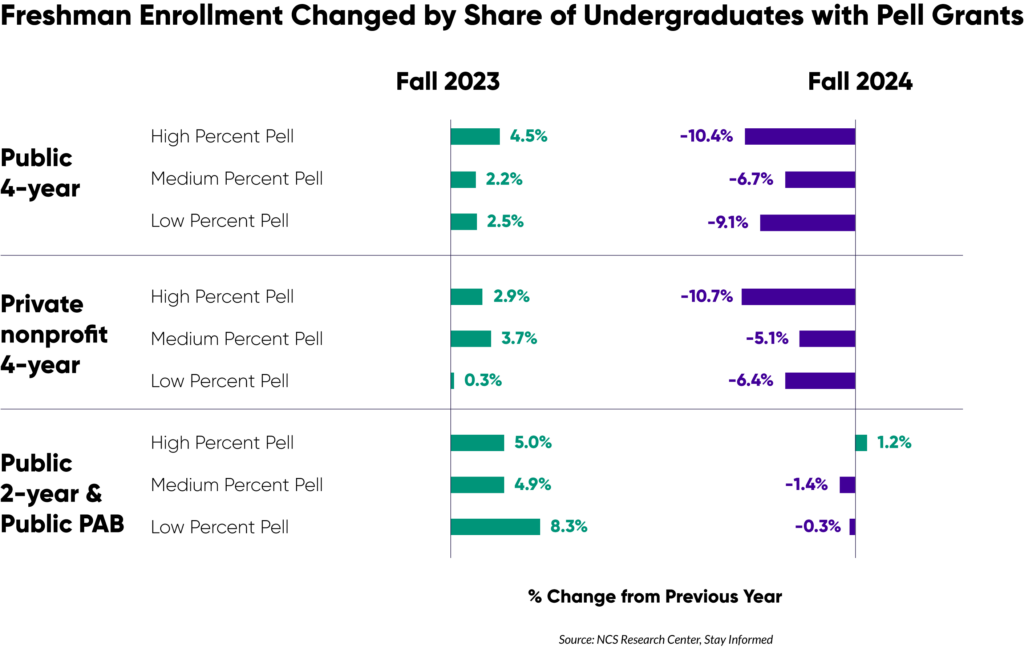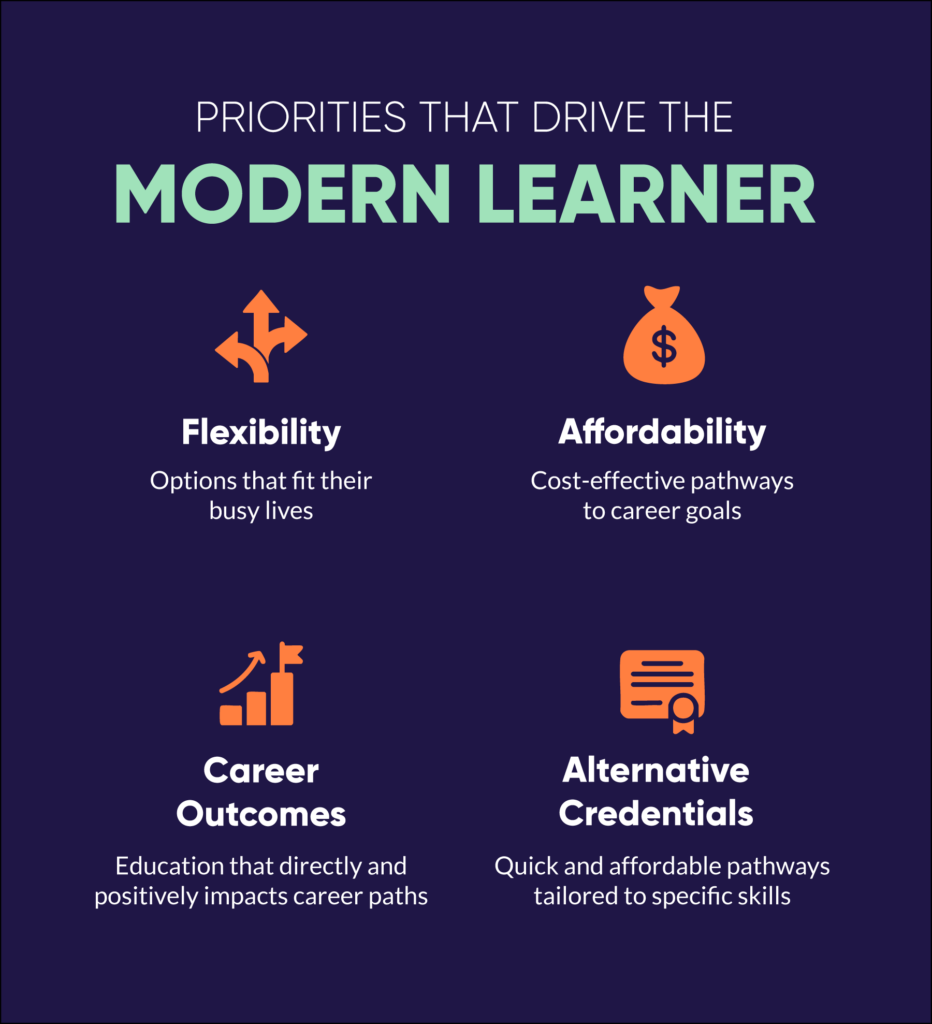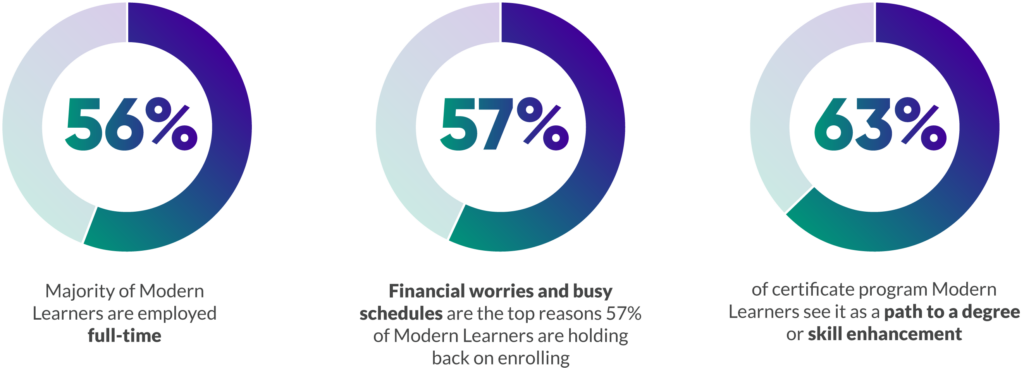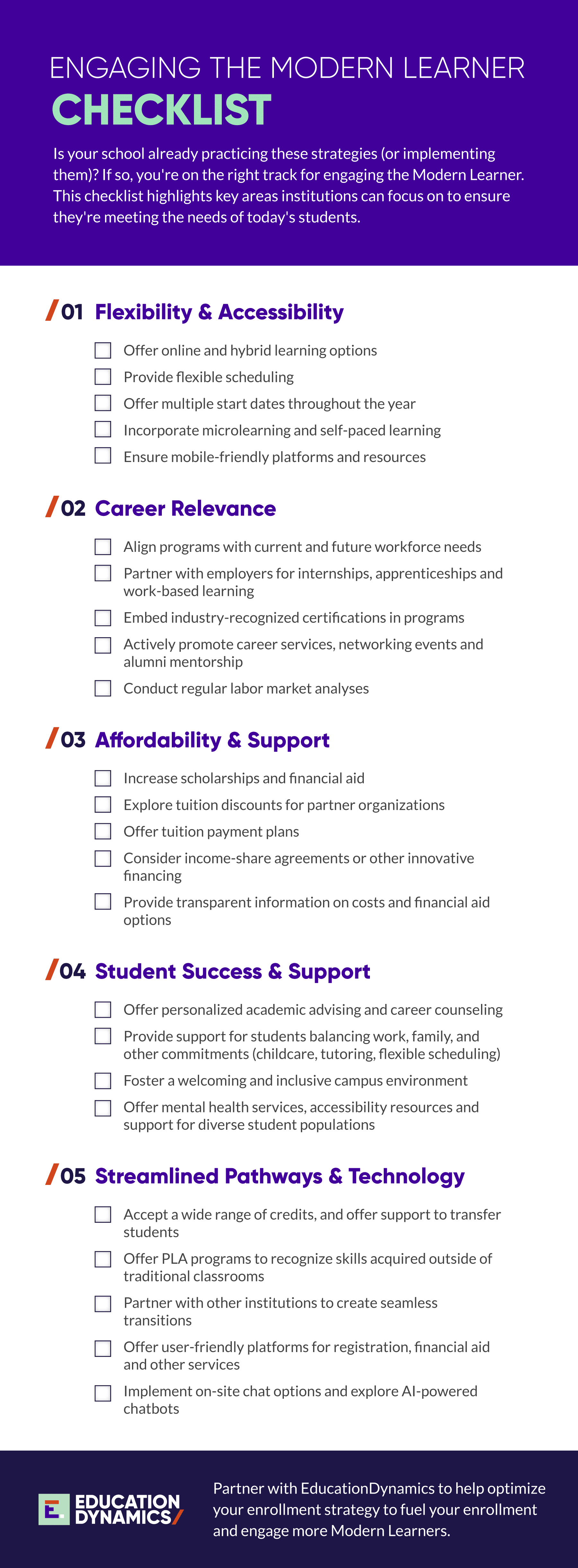The Enrollment Shift: Strategies for Engaging the Modern Learner

Meet Maria. A recent high school graduate with her sights set on a career in web development, Maria surprised her family by choosing a six-month accelerated certificate program at a local community college over a traditional four-year computer science degree. Why? Because Maria, like many of today’s learners, prioritizes a fast track to career readiness, affordability and the flexibility to learn at her own pace. She’s not alone. This trend is playing out across the country, forcing institutions to rethink their approach to attracting and retaining students.
Maria’s story exemplifies the enrollment shift happening in higher education. Greg Clayton, the President of the EMS division of EducationDynamics says: “Higher education isn’t collapsing, it’s shifting. Schools must adapt to meet the evolving needs of today’s students or they will be left behind.” This shift is driven by a confluence of factors, from changing demographics to evolving student priorities and the rise of new technologies.
Changing How We Think About the Coming Enrollment Cliff
As we covered earlier this year in our blog post about the Enrollment Cliff, higher education is about to come up against a demographic shift that will impact first-year enrollment, starting with the Fall 2025 class. With this demographic “apocalypse” just on the horizon, all eyes and thoughts have been on what to do about a shrinking pool of 18-year-olds looking to start their first year of college.
However, as research from the National Student Clearinghouse Research Center (NSCRC) indicates, we may be looking at an Enrollment Shift that is happening concurrently with the Enrollment Cliff. The latest NSC data for 2024 shows that while enrollment rose 3% overall for the Fall 2024 term over the Fall 2023 term, Fall enrollment for incoming freshmen is down across all institutions at an average of 5%. To be clear, we have not hit the Enrollment Cliff yet. The importance of this data cannot be overemphasized. If 18-year-olds are already considering waiting or taking alternate paths to the workforce and obtaining a degree, the demographic shift will hit that much harder, over a longer period of time.
Digging further into the data reveals even more startling numbers, which show larger shifts in enrollment trends based on economic background. Compared to Fall 2023 enrollment, institutions which have a high percentage of students utilizing Pell grants, the retraction for both publics and private non-profits is over 10%. From the students’ perspective, “middle” income households are also seeing the steepest decline, at 8%.

So what does this tell us? It is telling us that the background noise over the past 5-7 years regarding the cost of getting a degree, the methodology with which they are achieved and the career/economic outcomes afterward are absolutely being reflected by the decisions people are making who are most impacted by these economic realities. It is telling us that the current model is not working, it is unsustainable – it is untenable for the students and it is untenable for the schools that are supposed to support them. Match this massive regression in the market with the actual Enrollment Cliff and the numbers are more than startling. It is in the millions, compounded by each year of subsequent birth decline.
And what is making up for this loss in incoming freshmen? As we have stated before, it is being fueled by a surge in “non-traditional” students – adult learners, international students and those returning to college to upskill or reskill. These students bring with them a wealth of experience and a clear sense of purpose, but they also have unique needs and expectations. Institutions must be prepared to cater to this growing population by offering programs and services that align with their goals and lifestyles.
Furthermore, the “some college, no credential” (SCNC) population, now numbering 36.8 million, represents a significant opportunity for higher education institutions. Re-enrollment among this group increased by 9.1% in the 2022-2023 academic year, demonstrating a growing desire for continued education and career advancement. Reaching out to this population and providing clear pathways for degree completion can be a valuable strategy for boosting enrollment and serving a population eager to advance their careers.
It’s also important to recognize that age is no longer a predictor of learning modality. Many younger students, like Maria, are opting for part-time enrollment, online programs, or alternative credentials that offer a quicker path to employment. The Modern Learner, regardless of age, demands flexibility and relevance. They are digital natives, accustomed to accessing information and services online and they expect the same level of convenience and personalization from their educational experiences.
The Rising of the Modern Learner Era
The Modern Learner is a new breed of student, driven by a unique set of priorities:
- Flexibility:
Juggling work, family and other commitments, they need options that fit their busy lives. Online learning, hybrid programs and accelerated formats are essential. This also includes flexible payment options and scheduling options. They need to be able to access education when and where it works for them, whether it’s on their lunch break, during their commute, or late at night after the kids are asleep.
- Affordability:
Concerned about student debt and the return on their investment, Modern Learners seek cost-effective pathways to their career goals. They are looking for demonstrable value and a clear return on investment for their educational expenditures. They want to know that the skills and knowledge they gain will lead to better job prospects and higher earning potential.
- Career Outcomes:
Education is viewed as a means to an end. They demand programs aligned with industry needs, offering clear pathways to employment. Modern Learners want to know that their education will translate directly into career advancement and increased earning potential. They are looking for programs that offer practical skills, industry connections and career support services.

- Alternative Credentials: Certificates, apprenticeships and other non-degree options are gaining popularity for their focused, skills-based approach. These options often provide quicker, more affordable pathways to specific career skills, allowing learners to enter the workforce faster or upskill within their current roles. Stackable credentials, which allow learners to build upon their qualifications over time, are also becoming increasingly popular.
- 56% of online college students are employed full-time.
- 57% of online college students who delayed enrollment cited financial concerns or time constraints as the primary reason.
- 63% of students enrolled in a certificate program see it as a stepping stone to a full degree or a way to enhance their existing qualifications.
The data supports this shift. According to the Online College Students Report 2024:

The Rising of the Modern Learner Era
To thrive in this new era, consider some of these strategies higher education institutions to adapt to the needs of the Modern Learner.
Offer Flexible Learning Options
Expand online and hybrid learning modalities to cater to students who need flexibility in their schedules and learning environment. Offer evening, weekend and accelerated programs to accommodate those balancing work and family commitments. Provide multiple start dates throughout the year to allow students to enroll when it’s convenient for them. Consider incorporating modalities like microlearning and self-paced learning to further cater to individual needs. Offer mobile-friendly learning platforms and resources to allow students to learn on the go.
Focus on Career Relevance
Develop programs that align with current and future workforce needs. Partner with employers to offer internships, apprenticeships and other work-based learning experiences that provide students with practical skills and industry connections. Embed industry-recognized certifications within degree programs to enhance their value and marketability. Actively promote career services, networking events and alumni mentorship programs to connect students with career opportunities. Conduct regular labor market analyses to ensure programs are aligned with current and emerging industry trends.
Make Education More Affordable
Increase the availability of scholarships and financial aid to help students manage the cost of education. Explore tuition discounts for employees of partner organizations to incentivize upskilling and reskilling. Promote tuition payment plans to make education more accessible to those with limited financial resources. Consider offering income-share agreements or other innovative financing models to align the cost of education with future earning potential. Provide clear and transparent information about tuition costs and financial aid options.
Provide Robust Student Support Services
Offer personalized academic advising and career counseling to help students navigate their educational journey and achieve their career goals. Provide support for students balancing work, family and other commitments, such as childcare resources, online tutoring and flexible scheduling options. Create a welcoming and inclusive campus environment where all students feel supported and valued. Offer mental health services, accessibility resources and dedicated support for diverse student populations, including first-generation students, veterans and students with disabilities.
Streamline the Transfer Credit Process
Implement a clear and transparent transfer credit policy to facilitate the seamless transfer of credits from other institutions. Adopt a generous policy on accepting transfer credits, recognizing the value of prior learning and experience. Provide dedicated support for SCNC students to help them navigate the re-enrollment process and complete their degrees. Consider implementing prior learning assessment (PLA) programs to grant credit for knowledge and skills acquired outside of the traditional classroom. Develop partnerships with community colleges and other institutions to create seamless transfer pathways.

Leverage Technology to Enhance the Student Experience
Use data analytics to personalize communication and support, tailoring messages and interventions to individual student needs. Implement user-friendly online platforms for course registration, financial aid and other services, making it easy for students to access information and complete tasks. Offer on-site chat options on school websites to provide immediate assistance and answer questions in real-time. Explore the use of AI-powered chatbots to provide 24/7 support and personalized guidance. Utilize virtual reality and augmented reality technologies to create immersive learning experiences.
Embracing the Enrollment Shift
The future of higher education depends on its ability to adapt to the evolving needs of the Modern Learner. Institutions that embrace flexibility, affordability, career relevance and student-centered approaches will be well-positioned for success.
It’s time to embrace the enrollment shift. By understanding the motivations and priorities of today’s students, higher education can evolve to meet the challenges and opportunities of the 21st century. This requires a shift in mindset, from a focus on traditional models of education to a more agile, responsive and student-centric approach.
EducationDynamics is your partner in navigating this changing landscape. We provide the expertise and solutions you need to attract, enroll and retain Modern Learners. Contact us today to learn more.